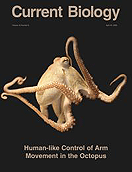
« PREVIOUS ENTRY
Artwork with more colors than printers can print
NEXT ENTRY »
Galvez: An imaginary Photoshopped city

Few things are more flexible than the noodly octopus arm; it has a nearly infinite number of degrees of freedom. But when it comes time to eat? Apparently octopi pull a neat trick — they initiate muscular contractions that create temporary “joints” that limit their arms’ range of movement, so that they move oddly like … human arms.
The scientists reported their findings in the recent issue of Current Biology, and a report on MSNBC describes it thusly:
Researchers recorded muscle activity in octopus limbs, and found that an arm generates two waves of muscle contractions that propagate toward each other. When the waves collide, they form a part-time joint.
This process occurs three times, forming a shoulder where the arm meets the body, a wrist where the suckers have grasped their food, and an “elbow” somewhere in between. The elbow typically exhibits the most movement during food retrieval.
The researchers say this is a remarkably simple and apparently optimal mechanism for adjusting the length of arm segments according to where the food item is grasped along the arm.
(Thanks to Yishay Mor for this one!)
I'm Clive Thompson, the author of Smarter Than You Think: How Technology is Changing Our Minds for the Better (Penguin Press). You can order the book now at Amazon, Barnes and Noble, Powells, Indiebound, or through your local bookstore! I'm also a contributing writer for the New York Times Magazine and a columnist for Wired magazine. Email is here or ping me via the antiquated form of AOL IM (pomeranian99).

ECHO
Erik Weissengruber
Vespaboy
Terri Senft
Tom Igoe
El Rey Del Art
Morgan Noel
Maura Johnston
Cori Eckert
Heather Gold
Andrew Hearst
Chris Allbritton
Bret Dawson
Michele Tepper
Sharyn November
Gail Jaitin
Barnaby Marshall
Frankly, I'd Rather Not
The Shifted Librarian
Ryan Bigge
Nick Denton
Howard Sherman's Nuggets
Serial Deviant
Ellen McDermott
Jeff Liu
Marc Kelsey
Chris Shieh
Iron Monkey
Diversions
Rob Toole
Donut Rock City
Ross Judson
Idle Words
J-Walk Blog
The Antic Muse
Tribblescape
Little Things
Jeff Heer
Abstract Dynamics
Snark Market
Plastic Bag
Sensory Impact
Incoming Signals
MemeFirst
MemoryCard
Majikthise
Ludonauts
Boing Boing
Slashdot
Atrios
Smart Mobs
Plastic
Ludology.org
The Feature
Gizmodo
game girl
Mindjack
Techdirt Wireless News
Corante Gaming blog
Corante Social Software blog
ECHO
SciTech Daily
Arts and Letters Daily
Textually.org
BlogPulse
Robots.net
Alan Reiter's Wireless Data Weblog
Brad DeLong
Viral Marketing Blog
Gameblogs
Slashdot Games